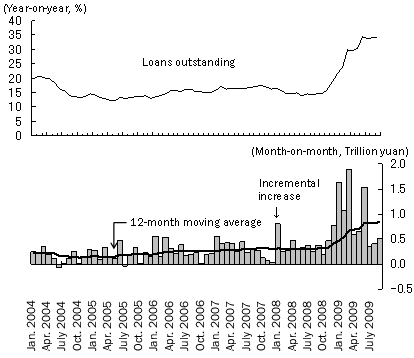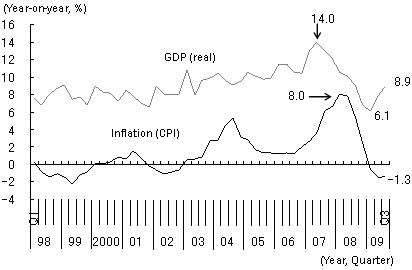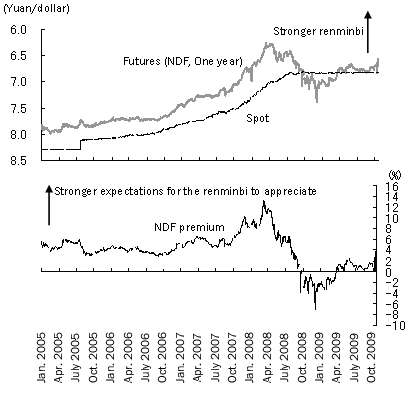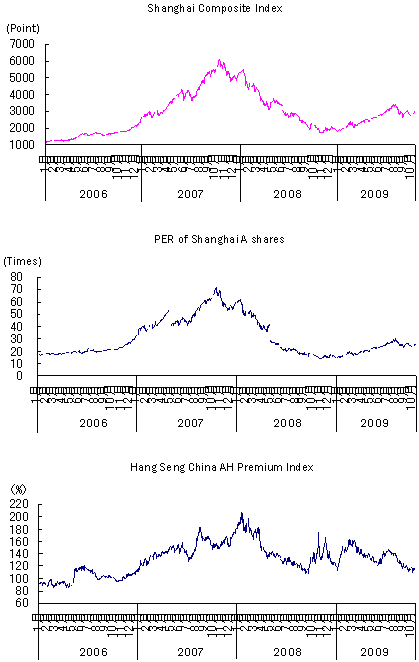Following the Lehman shock in September 2008, China adopted an ultra-loose monetary policy, cutting interest rates and removing limits on total bank lending as part of its economic stimulus measures. As a consequence, money supply and bank lending have risen sharply since the beginning of 2009. Combined with an economic stimulus package amounting to 4 trillion yuan announced in November 2008, this very easy monetary policy has been driving an economic recovery and a rise in share prices.
The rapid expansion in lending has also created the risk of a surge in nonperforming loans, prompting the Chinese authorities to begin revising their monetary policy in the summer of 2009. Although Chinese share prices experienced a temporary correction following this move, they are expected to rise as the economy recovers, since a sharp turn to monetary tightening is unlikely in the foreseeable future with inflation still negative. Thus the driving force for share prices will shift from liquidity to fundamentals.
Economic recovery gathers momentum
The real rate of economic growth in China (on a year-on-year basis) bottomed out at 6.1% in the first quarter of 2009. It then recovered to 7.9% in the second quarter and 8.9% in the third. Although external demand is falling, domestic demand items such as investment and consumption remain firm. In the January to September period, total nationwide investment in fixed assets (in nominal terms) rose 33.4% year on year, with growth in investment in the railway and transport industry in particular reaching 87.5%. Retail sales (in nominal terms) also rose, climbing 15.1% year on year. With inflation in negative territory (-1.1% in the January to September period), growth in retail sales in real terms (at 17.0%) was even higher than its nominal performance.
The average rate of economic growth from the first quarter through the third quarter of 2009 was 7.7%. Growth in the fourth quarter is likely to exceed 9% and China should have no problem achieving growth of 8% targeted by the government for the full year. There are several reasons for this. First, because growth in the fourth quarter of 2008, the starting point for the comparison, slowed to 6.8% in the wake of the Lehman shock, it is all the more likely that the growth rate for the fourth quarter of 2009 will be high. In addition, as growth in industrial production (on an added-value basis) in September was 13.9%, above the overall growth of 12.4% for the third quarter, showing that industrial production and in turn gross domestic product (GDP) are accelerating. Moreover, imports, which serve as a leading indicator of exports, declined only 3.5% year on year in September, a drop that was far short of the 17.0% fall seen in August, suggesting that exports are poised for a recovery.
The economic recovery in China is still in its initial stages. With the global economy likely to return to positive growth next year, China should achieve 9% GDP expansion in 2010, outperforming this year.
Seeking an exit strategy for monetary and foreign exchange policies
With the economic recovery gaining momentum, the Chinese authorities have begun looking for an exit strategy from the extreme monetary easing it has been employing, as symbolized in the smaller monthly rises in lending seen since summer ( figure 1 ). Although share prices experienced a temporary correction in August following this move, the action should be valued as a necessary ingredient for sustained growth, given that the banking sector's bad debt could rise sharply if the sharp increase in lending had been left unaddressed.

(Source)Prepared based on data from The People's Bank of China
However, although the ultra-loose monetary easing is being revised, year-on-year lending growth in September was still high, at 34.2%. When the authorities will switch to clear monetary tightening is being closely watched. Given past experience, one benchmark will be when the inflation rate as measured by the year-on-year increase in the consumer price index (CPI) exceeds 4%. With current inflation still negative and inflation generally lagging about three quarters behind the growth rate, it is unlikely that authorities will begin tightening in earnest until the second half of next year at earliest ( figure 2 ).

(Source)Prepared based on data from the National Bureau of Statistics of China
In addition to monetary policy, the foreign exchange policy hitherto adopted-namely, keeping the renminbi against the dollar-will also be revised. Although China moved from the dollar peg to a managed floating rate system in July 2005, it has effectively returned to the latter system as part of its crisis management, evidenced by the fact that the exchange rate of the renminbi against the dollar has remained at around 6.85 yuan since the summer of 2008. The Chinese authorities successfully dealt with the Asian currency crisis in 1997 and 1998 by sticking to a policy of stabilizing the renminbi against the dollar, when the renminbi was exposed to strong devaluation pressure. This approach is being used again in the latest financial crisis. As seen in 2007, however, given the specter of inflation as the economy recovers, the Chinese authorities will have no choice but to accept a rise in the exchange rate of the renminbi against the dollar once again as the financial crisis eases. The market has anticipated this, which is why the premium of the non-deliverable forward (NDF) rate (one year), equivalent to renminbi futures, over the spot rate has been widening ( figure 3 ).
Share prices: still ample room to rise
The Shanghai Composite Index regained the 3,000 point level in mid-October, after a correction in August, and is up more than 70% from its low in November 2008. This has prompted some market observers to express the concern that share prices in China are already in bubble territory, and may collapse.
- Spot Vs. Futures (NDF) -

(Note)The spot rate of the renminbi is directly affected by the policies of the Chinese authorities, such as intervention, while the futures (NDF) rate traded overseas better reflects market demand and supply.
(Source)Prepared based on data from Bloomberg and the State Administration of Foreign Exchange of China
In judging whether the share prices currently prevailing on the Shanghai Stock Exchange are excessive or not, the price earnings ratio (PER) and the Hang Seng AH premium index serve as useful guides ( figure 4 ).
First, the PER of "A" shares listed on the Shanghai Stock Exchange is currently around 25, much lower than the 70-plus at the peak of the bubble in October 2007. Given that China is an emerging economy and its growth potential is much greater than that of industrialized economies, share prices at the moment certainly do not seem high relative to corporate earnings.
Also, the Hang Seng AH premium index has fallen sharply from its peak. There are 59 Chinese stocks simultaneous listed on the Shanghai Stock Exchange (A shares) and the Hong Kong Stock Exchange (H shares), but their share prices in the two markets do not necessarily coincide given capital controls in mainland China, such as restrictions on securities investment by non-residents. The main players in the stock market for H shares are foreign institutional investors who tend to emphasize the fundamentals, while those in the market for A shares are individual Chinese investors who tend to be more speculative. The AH premium index, which shows the relative price of A shares to H shares, temporarily topped 200% at the peak of the bubble, but it has contracted to 120%, making A shares relatively less expensive.
- Spot Vs. Futures (NDF) -

(Source)Prepared based on Bloomberg data
The sustainability of China's economic recovery and the policy stance of its monetary authorities are critical factors determining the future course of share prices. Premised on our projections that growth in 2009 will reach about 9% and that a full-scale tightening will not occur before the second half of 2010, the environment for share prices will remain favorable for now, with low interest rates, low inflation, and a recovering economy.


